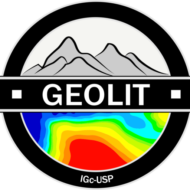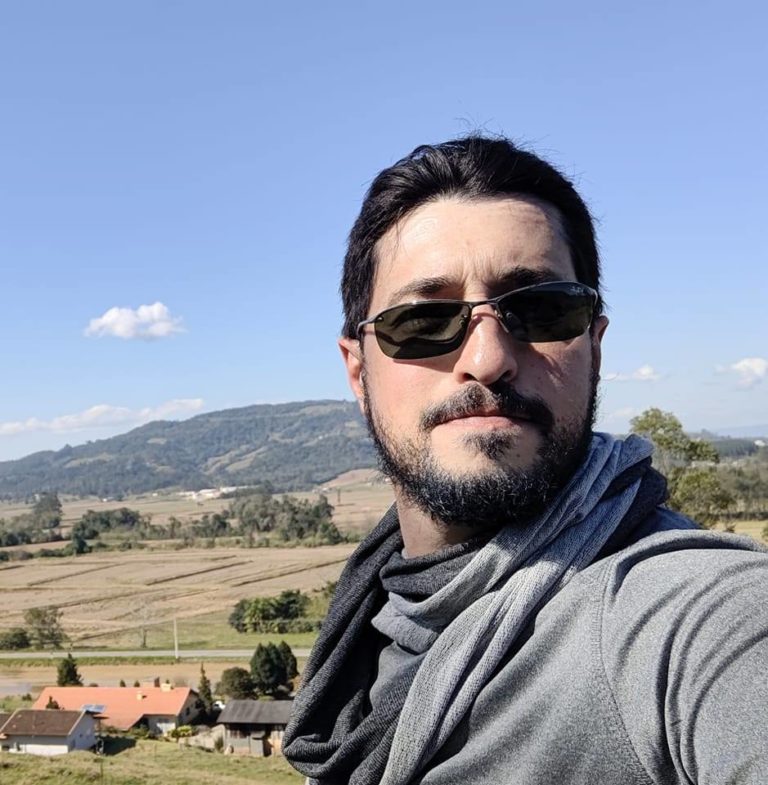
GEOLIT - Lithosphere Geosciences Research Group

My expertise is in Potential Field Methods, Gamma-Ray Spectrometry and Remote Sensing. Lately, I have been studying Machine and Deep Learning to integrate large datasets, common in these methods. Each project I work on proves these methods versatile and appliable to a considerable range of problems, from volcanic activity to environmental salvage. My passion, as a researcher, is volcanic activity, which is not quite common for someone who lived most of his life in a country with no volcanic activity since the Pleistocene.
New technologies are requiring a reassessment of not only data but of many Earth Sciences questions. For example, magnetic field data has been used for decades as a secondary method for volcano monitoring, gathering only intensity data – which changes according to geometric and temperature changes in the magma chamber. However, new technologies as the Internet of Things (IoT), Low Power, Wide Area (LPWA) networking protocols, and Arduino-like microprocessor units allow us to develop magnetometer networks to monitor all vector components of the magnetic field almost in real-time. Or using drones for high-resolution surveys at minimum costs.
In 2017, I joined as an assistant professor at the University of São Paulo. Two years later, I re-founded the GEOLIT Group, renaming it to Geoscience of the Lithosphere Research Group (GEOLIT | IGc – USP) to include fellow geologists from my institute. The group now counts with 30 students of different levels, four professors, and three geophysicists from the industry. A few months later, I co-founded the Artificial Intelligence in Geosciences Laboratory (Intelli+Geo), which promoted an online Artificial Intelligence workshop that reached more than 1500 people.
Today, my research has two fronts: the geohazard and the exploratory. The geohazard front relies on developing a low-cost Arduino-based magnetometer net, including IoT technology and LPWA networking protocols to monitor changes in the magma chamber from volcanoes. Changes in the magma chamber cause subtle contrasts in the magnetic field over it. Volcanic monitoring efforts have been using this methodology for a long time, but with a single magnetometer. I intend to employ low-cost technologies to comprehend variations in volcanic magnetization throughout time. These variations include the magnetic inclination and declination of the body. Seismological and InSAR data will complement the magnetic field data. The magnetometers are in the prototype phase, using two Arduino Uno protoboards, a low-precision magnetic sensor, and two LoraWAN® antennas.
In the exploratory front, the fieldworks developed in 2019, summed up to open-source data, allowed us to conduct a large-scale investigation in the Alta Floresta Gold Province (AFGP). We gathered geophysical, geomorphological, petrophysical, petrological, geochemical and isotope data to evaluate AFGP’s gold prospects. The results support the search for new targets. The large dataset is also under scrutiny using Machine and Deep Learning algorithms, enhancing the interpretation. With the whole dataset in hand, the GEOLIT group will discuss the present theory of evolution of the province, the mineralization styles and, ultimately, the potential for gold production.
I consider myself a versatile researcher. My passion is, undoubtedly, volcanism. However, becoming a researcher in a country without active volcanoes made me learn to work better in other areas without losing sight out of my passion. It also made me behave better within a group, even if out of my area of expertise. Geophysics has its physical limitations, but creativity expands its application, and there is where I like to work. No matter where I research, I will seek to continue exploring new forms to understand the dynamics of active volcanoes and prevent losses from their eruptions.
Publications
-
-
-
- Vasconcelos, T.Q.F., Janasi, V.A, Mello, J.T., Louro, V., 2023. The Campinas-Jaguariúna sill, NE Paraná magmatic province, Brazil: Insights on the mechanisms of emplacement and differentiation from geochemical and magnetic data. Journal of South American Earth Sciences, In press, 104370, doi: 1016/j.jsames.2023.104370.
- Dutra, L.F., Louro, V.H.A., Monteiro, L.V.S., 2023. The southern IOCG and hydrothermal nickel mineralization trend of the Carajás Mineral Province: Airborne geophysical and remote sensing evidences for structural controls and hydrothermal signature. Journal of Applied Geophysics, 213, 105016, doi: 1016/j.jappgeo.2023.105016.
- Sergipe, P.P., Louro, V., Marangoni, Y.R., Moura, D.S., Jovane, L., 2023. A study of volcanic rocks and ferromanganese crusts through marine geophysical methods integration in the north portion of Cruzeiro do Sul Rift in the Rio Grande Rise. Frontiers Marine Sciences, 10, doi: 3389/fmars.2023.1093108.
- Barros, M.F.S., Louro, V.H.A., Terada, R., Marques, C.H.G., Saraiva, F.A., Almeida, E.R., Hirata, R., 2022. Geoelectrical anomalies associated to groundwater contamination in Urânia (SP, Brazil). Journal of Applied Geophysics, 2026, 104807, doi: 1016/j.jappgeo.2022.10480
- Santos, V.S., Gloaguen, E., Louro, V.H.A., Blouin, M., 2022. Machine Learning Methods for Quantifying Uncertainty in Prospectivity Mapping of Magmatic-Hydrothermal Gold Deposits: A Case Study from Juruena Mineral Province, Northern Mato Grosso, Brazil. Minerals 2022, 12, 941, doi: 3390/min12080941.
- Souza Junior, G.F., Trindade, R.I.F., Temporim F.A., Bellon, U.D., Gouvêa, L.P., Soares, C.C., Amaral, C.A.D., Louro, V., 2021. Imaging the roots of a post-collisional pluton: Implications for the voluminous Cambrian magmatism in the Araçuaí orogen (Brazil). Tectonophysics, 821, 229146, doi: 1016/j.tecto.2021.229146.
- Lino, L.M., Quiroz-Valle, F.R., Louro, V., Basei, M.A.S., Vlach, S.R.F., Munõz, P.M., 2021. Synorogenic and post-collisional volcano-sedimentary sequences from Campo Alegre – SC, Southern Brazil. Journal of South American Earth Sciences, 107, 103147, 1 – 22, doi: 1016/j.jsames.2020.103147.
- Barros, M.F.S., Louro, V.H.A., Terada, R.K., Marques, C.H.G., Saraiva, F.A., Hirata, R., 2021. Vertical Electrical Soundings in the mapping of vulnerability to contamination of the Adamantina aquifer in Urânia (SP). Geologia USP – Série Científica, doi: 11606/issn.2316-9095.v21-173647.
- Negrão, A.P., Mello, C.L., Ramos, R.R.C., Souza, M.R.S., Louro, V.H.A., Bauli, P.G., 2020. Tectonosedimentary evolution of the Resende and Volta Redonda basins (Cenozoic, Central Segment of the Continental Rift of Southeastern Brazil). Journal of South American Earth Sciences, 102789, 1-20, doi: 1016/j.jsames.2020.102789.
- Louro, V.H.A., Negrão, A.P., Castro, L.G., Ferreira, F.J.F., 2019. Canoas geophysical anomaly: A possible alkaline body or unusual anomaly caused by mafic dykes in the Ponta Grossa Arch, Brazil? Journal of Applied Geophysics, 170, 103857, doi: 1016/j.jappgeo.2019.103857.
- Louro, V.H.A., Cawood, P.A., Mantovani, M.S.M., Ribeiro, V.B., 2017. Tectonic insights of the southwest Amazon Craton from geophysical, geochemical and mineralogical data of Figueira Branca mafic-ultramafic suite, Brazil. Tectonophysics, 708, 96-107, doi: 1016/j.tecto.2017.04.025.
- Louro, V.H.A., Mantovani, M.S.M., Ribeiro V.B., 2017. Integrated geological and geophysical interpretation of the Buraco da Velha Copper Deposit (Rondônia – Brazil): A basis for exploring in related environments. Geophysics, 82(3), B121-B133, doi: 1190/geo2016-0345.1.
- Mantovani, M.S.M., Louro, V.H.A., 2015. Ribeiro V.B., Requejo, H.S., Santos, R.P.Z. Geophysical Analysis of Catalão I Alkaline-Carbonatite Complex in Goiás, Brasil. Geophysical Prospecting, 64(1), 216-227, doi: 1111/1365-2478.12283.
- Louro, V.H.A., Mantovani, M.S.M., Ribeiro V.B., 2014. Magnetic Field Analysis of Morro do Leme Nickel Deposit. Geophysics, 79(6), K1-K9, doi: 1190/geo2014-0131.1.
- Ribeiro, V.B., Mantovani, M.S.M., Louro, V.H.A., 2014. Notas de aerogamaespectrometria e suas aplicações no mapeamento geológico – estudos de caso. Terræ Didática, 10(1), 29-51, doi: 20396/td.v10i1.8637386.
- Ribeiro, V.B., Louro, V.H.A., Mantovani, M.S.M., 2013. 3D Inversion of magnetic data of grouped anomalies – study applied to São José intrusions. Journal of Applied Geophysics, 93, 67-76, doi: 1016/j.jappgeo.2013.03.013.
- Louro, V.H.A., Mantovani, M. S. M., 2012. 3D inversion and modeling of magnetic and gravimetric data characterizing the geophysical Anomaly source in Pratinha I in the southeast of Brazil. Journal of Applied Geophysics, 80, 110-120, doi: 1016/j.jappgeo.2012.01.013.
-
-
© All Right Reserved 2021 GEOLIT